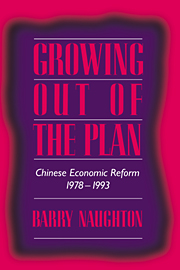Book contents
- Frontmatter
- Contents
- Tables and figures
- Preface
- Introductory
- Introduction: China's economic reform in comparative perspective
- 1 The command economy and the China difference
- Phase one The bird in the cage, 1979–1983
- Phase two Reforms take off, 1984–1988
- Phase three To a market economy
- Statistical appendix
- Notes
- Bibliography
- Index
Introduction: China's economic reform in comparative perspective
Published online by Cambridge University Press: 03 May 2010
- Frontmatter
- Contents
- Tables and figures
- Preface
- Introductory
- Introduction: China's economic reform in comparative perspective
- 1 The command economy and the China difference
- Phase one The bird in the cage, 1979–1983
- Phase two Reforms take off, 1984–1988
- Phase three To a market economy
- Statistical appendix
- Notes
- Bibliography
- Index
Summary
The traditional Soviet-style economic system scarcely exists any longer, but its impact and legacy will be felt well into the next century. Major economic reform programs are now underway in a dozen formerly socialist command economies. These reform programs differ in their speed, coherence, and general approach, but in all these countries an irreversible process of transition away from the Soviet model has begun. Each of the former planned economies is struggling to devise strategies of economic change while coping with the burdensome legacy of past development choices, and it is clear that the process of transition will be protracted. Economic reform of a planned economy is a process that takes decades, and several different paths lead through the borderlands separating planned and market economies.
Among this large and diverse group of nations, China has a particular claim on our attention. The chain of events that led to the collapse of Soviet-style socialism by the end of the 1980s can be traced back to the very beginning of the decade. At that time, profound change of radically different character began in two widely separated socialist countries. In China, beginning in 1979, radical economic reforms marked the first fundamental attempts to change the command economic system since the Yugoslav reforms of the 1960s. In Poland in 1980, the independent labor union Solidarity was formed, marking the first fundamental break with the Communist Party's monopoly of the political system.
Information
- Type
- Chapter
- Information
- Growing Out of the PlanChinese Economic Reform, 1978–1993, pp. 3 - 25Publisher: Cambridge University PressPrint publication year: 1995
